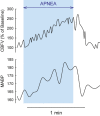Cerebrovascular consequences of obstructive sleep apnea
- PMID: 23130152
- PMCID: PMC3487354
- DOI: 10.1161/JAHA.111.000091
Cerebrovascular consequences of obstructive sleep apnea
Keywords: cerebrovascular circulation; cerebrovascular disease; dementia; ischemic attack, transient; sleep apnea syndromes; sleep apnea, obstructive; stroke.
Figures






Similar articles
-
Sleep-disordered breathing in acute ischemic stroke and transient ischemic attack: effects on short- and long-term outcome and efficacy of treatment with continuous positive airways pressure--rationale and design of the SAS CARE study.Int J Stroke. 2012 Oct;7(7):597-603. doi: 10.1111/j.1747-4949.2012.00836.x. Epub 2012 Jul 19. Int J Stroke. 2012. PMID: 22812731 Clinical Trial.
-
Sleep-related breathing disorders in cerebrovascular stroke and transient ischemic attacks: a comparative study.J Clin Neurophysiol. 2012 Apr;29(2):194-8. doi: 10.1097/WNP.0b013e31824d96b0. J Clin Neurophysiol. 2012. PMID: 22469687
-
Development, Validation, and Assessment of an Ischemic Stroke or Transient Ischemic Attack-Specific Prediction Tool for Obstructive Sleep Apnea.J Stroke Cerebrovasc Dis. 2017 Aug;26(8):1745-1754. doi: 10.1016/j.jstrokecerebrovasdis.2017.03.042. Epub 2017 Apr 14. J Stroke Cerebrovasc Dis. 2017. PMID: 28416405 Free PMC article. Clinical Trial.
-
Obstructive sleep apnoea and stroke.Lancet Neurol. 2004 Jun;3(6):333-42. doi: 10.1016/S1474-4422(04)00766-5. Lancet Neurol. 2004. PMID: 15157848 Review.
-
Cerebrovascular diseases and sleep-disordered breathing.Clin Exp Hypertens. 2006 Apr-May;28(3-4):225-31. doi: 10.1080/10641960600549108. Clin Exp Hypertens. 2006. PMID: 16833028 Review.
Cited by
-
The Association between Idiopathic Pulmonary Fibrosis and Obstructive Sleep Apnea: A Systematic Review and Meta-Analysis.J Clin Med. 2022 Aug 26;11(17):5008. doi: 10.3390/jcm11175008. J Clin Med. 2022. PMID: 36078938 Free PMC article. Review.
-
Sleep Apnea, Sleep Duration and Brain MRI Markers of Cerebral Vascular Disease and Alzheimer's Disease: The Atherosclerosis Risk in Communities Study (ARIC).PLoS One. 2016 Jul 14;11(7):e0158758. doi: 10.1371/journal.pone.0158758. eCollection 2016. PLoS One. 2016. PMID: 27415826 Free PMC article.
-
Cerebral vasoreactivity in response to a head-of-bed position change is altered in patients with moderate and severe obstructive sleep apnea.PLoS One. 2018 Mar 14;13(3):e0194204. doi: 10.1371/journal.pone.0194204. eCollection 2018. PLoS One. 2018. PMID: 29538409 Free PMC article. Clinical Trial.
-
Hypertension and dementia.Hypertension. 2014 Jul;64(1):3-5. doi: 10.1161/HYPERTENSIONAHA.114.03040. Epub 2014 Apr 28. Hypertension. 2014. PMID: 24777976 Free PMC article. No abstract available.
-
How does obstructive sleep apnea alter cerebral hemodynamics?Sleep. 2023 Aug 14;46(8):zsad122. doi: 10.1093/sleep/zsad122. Sleep. 2023. PMID: 37336476 Free PMC article.
References
-
- Somers VK, White DP, Amin R, Abraham WT, Costa F, Culebras A, Daniels S, Floras JS, Hunt CE, Olson LJ, Pickering TG, Russell R, Woo M, Young T. Sleep apnea and cardiovascular disease: an American Heart Association/American College of Cardiology Foundation Scientific Statement from the American Heart Association Council for High Blood Pressure Research Professional Education Committee, Council on Clinical Cardiology, Stroke Council, and Council on Cardiovascular Nursing: in collaboration with the National Heart, Lung, and Blood Institute National Center on Sleep Disorders Research (National Institutes of Health). Circulation. 2008;118:1080-1111 - PubMed
-
- Jelic S, Le Jemtel TH. Inflammation, oxidative stress, and the vascular endothelium in obstructive sleep apnea. Trends Cardiovasc Med. 2008;18:253-260 - PubMed
-
- Parati G, Lombardi C, Narkiewicz K. Sleep apnea: epidemiology, pathophysiology, and relation to cardiovascular risk. Am J Physiol Regul Integr Comp Physiol. 2007;293:R1671-R1683 - PubMed
-
- Mohsenin V. Sleep-related breathing disorders and risk of stroke. Stroke. 2001;32:1271-1278 - PubMed
-
- Yaggi H, Mohsenin V. Obstructive sleep apnoea and stroke. Lancet Neurol. 2004;3:333-342 - PubMed
Grants and funding
LinkOut - more resources
Full Text Sources

